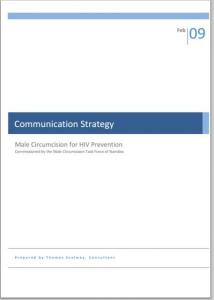Communication Strategy for Male Circumcision for HIV Prevention [Namibia]
This document serves as a broad frame of reference for the planning and implementation of communication programming around male circumcision for HIV prevention.
It outlines how male circumcision (MC) communication programming should be integrated within the broader Namibian HIV Prevention Strategies.
A phased approach is recommended. The first priority is to respond to immediate needs, including clear information for policymakers, service providers, and the media. The next phase includes the scale up of MC services. Communication issues relating to each of these objectives are laid out, and some sample outputs are suggested. This strategy recommends the eventual launch of a broad combination prevention campaign, with the working title of “Prevention Max!”. This is because MC needs to be communicated as just one part of a broader HIV prevention approach.
Source: FHI 360
Date of Publication: March 25, 2019
SIMILIAR RESOURCES
Tools
Examples
- Generic Algorithm to Aid Action Planning at District and Regional Levels
- SBCC for Malaria in Pregnancy: Strategy Development Guidance
- Integrated Management Strategy for Dengue Prevention and Control
- Practical Guidance for Risk Communication and Community Engagement (RCCE) for Refugees, Internally Displaced Persons (IDPs), Migrants, and Host Communities Particularly Vulnerable to COVID-19 Pandemic
- CDC’s Guiding Principles for Public-Private Partnerships: A Tool to Support Engagement to Achieve Public Health Goals
- KAP COVID: Exploring Knowledge, Attitudes, and Practices for COVID-19 Prevention
- Promoting Quality Malaria Medicines Through SBCC: An Implementation Kit
- Writing a Communication Strategy for Development Programmes: A Guideline for Programme Managers and Communication Officers
- Ajustement à bases factuelles des mesures de santé publique et des mesures sociales / Evidence-based Adjustment of Public Health and Social Measures
- Template for Stakeholder Engagement Plan

